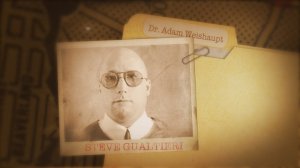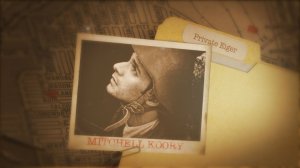Welcome back for the conclusion of our chat with Mike Zawacki, director of steampunk short film Wars of Other Men, and Scott Norman, who plays the Lieutenant.
Read Part 1 here
Read Part 2 here
Read Part 3 here
Airship Ambassador: What do you do to keep a balance between steampunk projects and the rest of your life?
Mike Zawacki: I have two kids, which is a pretty handy built-in limiter. They’re my number one priority so I just make sure that we’re all spending enough time together and work on projects as much as possible on the side. Having a day job is another built-in gauge for how much time you should be spending doing what. The end result is a lot of juggling, but I just keep checking in with my family, filmmaking friends, and coworkers to make sure everything’s getting the care and feeding it needs.
AA: Do you get to talk much with other writers and film makers to compare notes, have constructive critique reviews, and brainstorm new ideas?
MZ: Yeah, as much as possible. Honestly I wish I could do that more. You learn a lot by watching other people work, and by having them watch you work, and then talking about the process afterword. A lot of the people who crewed Wars are friends who are really talented filmmakers in their own rights who were just pitching in on a project they thought would be cool and fun, so we all end up talking shop while we’re on set or hanging out afterwards. I like going to screenings and talking to the filmmakers after watching their film, and vice versa. In my semi-professional opinion that’s a really important part of keeping sharp and increasing your skills.
Scott Norman: We have a small team we’re currently working with to develop the next TWOOM project. It really does help to bounce ideas off each other and compare notes. Each of us has a different relationship to the story and the project, and different levels of experience in the world and with the military. I think it’s a good mix.
AA: How have you and your work grown and changed over time?
MZ: As you make films your grasp of effective writing and visual storytelling will get stronger, so there’s that. Also I’ve gotten away from doing straight horror or straight action and have worked hard to add some solid story and emotional components to whatever I’m doing.
AA: How is Michigan for this kind of project? Does location matter for resources, access, publicity, etc
MZ: It’s a good place to make films, though the film incentives changed the game for us indie players. In a way it’s been a double-edge sword. On the one hand it’s brought a lot of really talented crew into the state – folks with industry experience and some really solid skills. If you can present them with an idea that really grabs them they may come aboard and bring that skillset or even equipment that you wouldn’t have access to otherwise.
On the other hand, where you use to be able to get people really excited by the mere fact that you were making a film and turn that into some really cool opportunities for locations or other resources now it’s like “Yeah, well ‘Superman vs Batman’ just came through and gave me 10 grand to use my bar for a film. What are you gonna do for me?”. So you take out passion and replace it with money. It’s not always like that – there are still lots of really neat people who want to do neat things – but it does happen more than it used to.
That said, the upside is that Michigan filmmakers who apply for participation in the program get access to a lot of state held locations. So Keith Jefferies, who was our Director of Photography, made a very cool short film called Tommy Button and was able to shoot a bunch of it in a Michigan state prison. It added a ton of production value to the film and didn’t cost Keith a dime.
AA: Most of the people I’ve talked with have some type of day job and that writing is their other job. What has that situation been for you and how has it helped/hindered in creating and promoting Wars?
MZ: Thankfully the companies I’ve worked for have all been very good about letting employees pursue outside projects like Wars, so I’d say being able to go to TeslaCon with your boss’ blessing (I actually invited my boss to come along!) is a huge help in making and promoting films.
SN: Lately, I’ve considered the creating/writing my main job that doesn’t pay yet because of this “other job” during the day that gets in my way. Having the other job pays the rent, and also forces me to fit in the writing and creating before I let it take my energy. So, in that way it helps. But, it is a hindrance when the schedule just doesn’t allow for certain conversations, meetings, or convention visits.
AA: Do people outside the steampunk and convention communities recognize you for Wars? What kind of reactions have you received?
MZ: Outside of the Steampunk community I’m usually only recognized by other filmmakers, which is kind of neat in and of itself. And that’s fine – I think being super famous or whatever would freak me out and ruin my life.
AA: Looking beyond steampunk, filming and working, what other interests fill your time?
MZ: Well there’s the aforementioned parenting! Outside that I really like natural building and hippy type stuff like that. Doing the research for Wars turned me on to the world of military surplus weapon collecting, so now I do that! Most of my guns are World War II or earlier guns from communist countries.
AA: What other fandoms are you part of in some way?
MZ: I’m a giant, shameless sci-fi, fantasy, and role-playing dork. As your readers have probably guessed I’m into military history. I’m also really interested in the history of the internet and computing in general. Almost every job I’ve ever had has been tied into some sector of deep geek internet history, so it just kind of grew out of that.
AA: How do those interests influence your work?
MZ: Well the sci-fi and military history things are hopefully obvious! Also I think being into sci-fi primes you to look at things differently and ask lots of “what if” type questions.
AA: Who or what do you count as your influences, motivators, or role models?
MZ: There are a lot of them! Influence-wise where films are concerned Joss Whedon is a big one, both in terms of what’s on the screen and how he seems to deal with the folks he works with. John Hillcoat’s films – the sparseness, desolation, and poignancy of films like “The Proposition” and “The Road” are really memorable and amazing. In terms of motivation? Having fun, collaborating with cool people, contributing to a community, telling interesting stories, all those are big ones. And it’s going to sound cheesy but my two biggest role models are my mom and dad. They’re just generally awesome people and spectacular parents. And now that I have kids of my own that appreciation for them has deepened.
AA: Three quick fire, random questions – what is your favorite time of day, condiment, and famous artwork?
MZ: Oh jeez…. Um, nighttime, horseradish, and Franz Marc’s Blue Horses.
SN: Whenever I happen to be most awake, ketchup, and I don’t pick favorites when it comes to art.
AA: Any final thoughts to share with our readers?
MZ: Make more films! Especially you Steampunks! Seriously. We have an awesome community and a fun, creative, and visually distinctive genre. It would be way too easy for Hollywood to come in, rip all the cool stuff out of Steampunk, and just leave the gears, goggles, and top hats. And then they’ll give it to Michael Bay. Do you really want “MICHAEL BAY’S STEAMPUNK” become the thing that introduces a broad swath of the world to Steampunk? We can do a better job that’ll be truer to the roots of our community and will include all the fun, whimsy, history, creativity, and general awesomeness. So the parting shot is: get out there and make cool stuff that will show the world what Steampunk can really be.
Thanks, Mike and Scott, for sharing all the great stories about making The Wars of Other Men.
Follow the latest news and information on the movie’s website, twitter, and facebook.
Information is also on IMDB, the internet movie database.




















